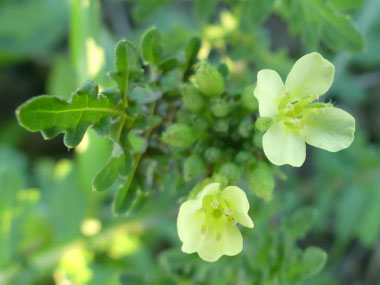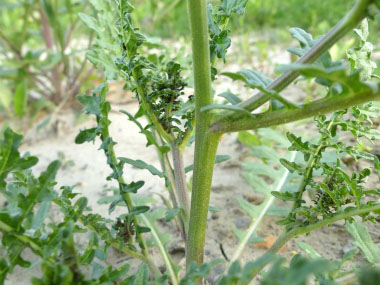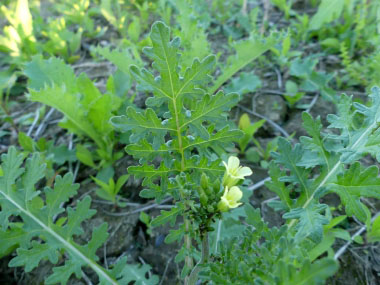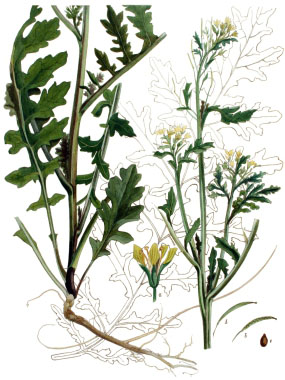








To support our efforts please browse our store (books with health benefits, etc.).
Dog mustard is in the Brassicaceae (Mustard) family. It is an annual or biennial plant which has a long taproot. The plant is native to Europe and Asia but is an introduced species in many other areas of the world, including much of Canada and the U.S. It is a weedy plant with an erect upright habit or sometimes with ascending tops with bright yellow flowers.
Distinguishing Features
When looking at just the flowers, one might think all yellow mustards look alike, but dog mustard is distinguished from the others by its pale yellow flowers, narrow and erect sepals, deeply lobed leaves, ascending fruit, and the stiff hairs on sepals, leaves, stalks and stems. The leaf size can be quite variable, especially lower and basal leaves, and may be affected by moisture and other environmental conditions.
Flowers
Elongating clusters of stalked flowers are at the top of the plant and at the ends of branching stems. A small cluster of a few to several flowers bloom at the tip and fruit form below. Flowers are pale yellow to nearly white, measuring 6 to 8mm (1/4 to 1/3”) across. Four petals are rounded, spatula shaped, narrowed at the base, the tip half widely spreading. In the centre are 6 yellow stamens and a short style. Flowers are in bloom from April well into the summer months.
 Fields
of Nutrition has medicinal benefits and vitamin/mineral content of Dog Mustard.
Fields
of Nutrition has medicinal benefits and vitamin/mineral content of Dog Mustard.
Leaves
Leaves are deeply divided, oblong or widest near the tip (oblanceolate) in outline. They are pinnately lobed with 3 to 10 major lobes per side, the lobes are mostly narrow with the edges shallowly lobed and rounded or angled at lobe tips. Leaf surfaces and leaf stalks are sparsely covered in stiff, and curved.
Height
Dog mustard plants can grow to 60 cm (2') tall. Stems are usually branched, erect to ascending, and sparsely to moderately covered in stiff, curved, appressed white hairs.
Habitat
This mustard likes part shade or full sun. It likes disturbed soils; agricultural fields, roadsides, waste areas, and gravel pits.
Edible Parts
Leaves and flowers are edible.
Other Name
Hairy Rocket.
Similar Plants
Tumble Mustard.
Winter Survival Food Handbook

PDF Plant Magazines
Types of Wild Food
Geographic Zones Seasons
Disclaimer
EdibleWildFood.com is informational in nature. While we strive to be 100% accurate, it is solely up to the reader to ensure proper plant identification. Some wild plants are poisonous or can have serious adverse health effects.
We are not health professionals, medical doctors, nor are we nutritionists. It is up to the reader to verify nutritional information and health benefits with qualified professionals for all edible plants listed in this web site. Please click here for more information.
Why Edible Wild Food?
- Food costs are rising
- Free, wild food is readily abundant
- Wild food adds nutrition to your diet
- Wild food can help treat various medical conditions





